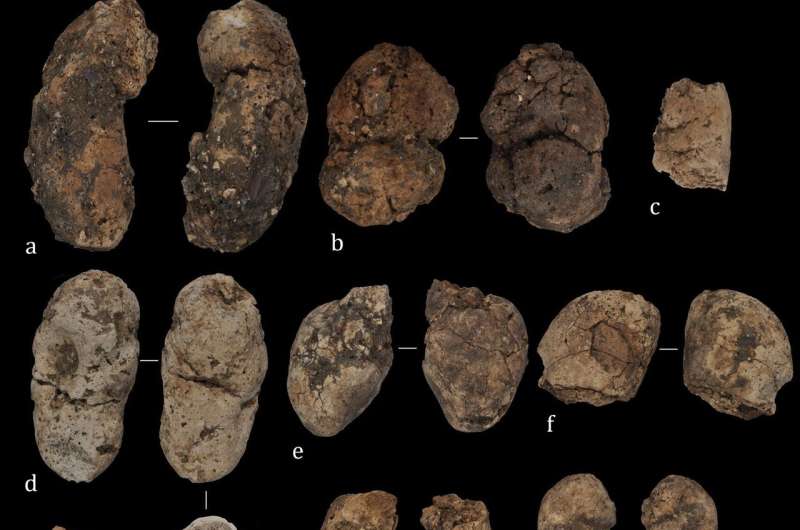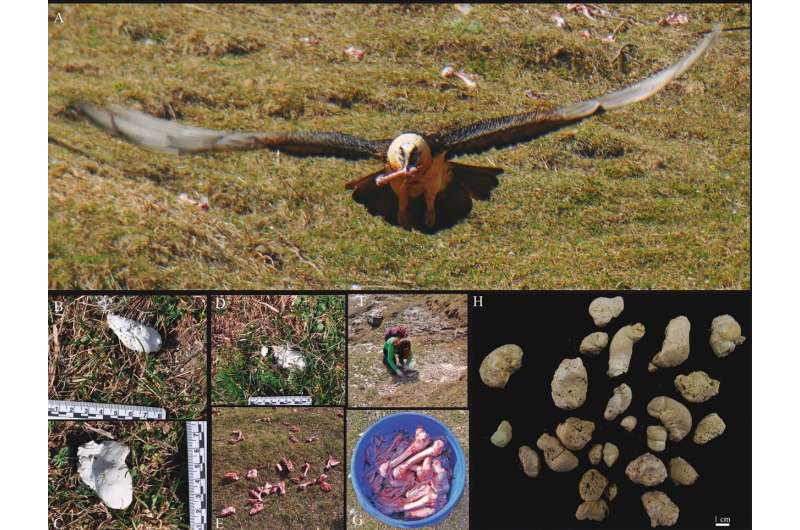Coprolites identify oldest bearded vulture nest in the Paleolithic Iberian Peninsula

Coprolites (fossil feces) from around 30,000 years ago have been used to identify the presence of bearded vultures (Gypaetus barbatus) at the Paleolithic site of Lagar Velho (Portugal). A comparison of the coprolites found in the excavations with the feces of present-day lammergeyers has confirmed the presence of these animals in the past. The research study, published in the journal Scientific Reports, points out the importance of identifying the coprolites when documenting the presence of these birds in the sites and studying the relationship they had with prehistoric human communities.
The identification of a nest allows us to know how these vultures lived. They had a peculiar diet, as 70-80% of their food consisted of bones. The valley in which the site is located must have been an optimal place for this species to establish nests, as confirmed by the large number of coprolites recovered in the excavation, as well as the bones digested by these vultures. This also opens the door to discovering the relationship between humans and vultures in the past, since the site has also documented the activities of groups of hunters and gatherers.
The Lagar Velho site is the fifth site in which the presence of bearded vulture nests has been documented in southern Europe, along with those of Gritulu (Corsica), Grotte Noisetier (France), El Mirón (Spain) and Caldeirao in Portugal—the latter yet to be confirmed—and is the first of the Iberian Peninsula in which their fossilized feces have been identified.
“Bearded vultures are vultures that have gone largely unnoticed until now in the archaeological record, even though they live in caves and accumulate bones, like human groups of hunters and gatherers,” says Sanz, first author of the article and researcher at the Prehistoric Studies and Research Seminar (SERP). The published study establishes, for the first time, characteristics and criteria for more easily identifying the coprolites of these vultures and their presence in antiquity. The identification of the bearded vulture at the Lagar Velho site also opens up new perspectives on the presence of the bearded vulture in Portugal.

To study these feces from thousands of years ago, the researchers compared the preserved samples with those of present-day bearded vultures living in the Ordesa y Monte Perdido National Park, as well as various samples provided by the Foundation for the Conservation of the Bearded Vulture. “There is very little difference between the present-day feces and those from 30,000 years ago, practically only the color, which makes them highly reliable when it comes to making identifications,” notes Sanz.
Currently, this vulture is a bird highly threatened by anthropic pressure, to the point that its populations have been reduced in the Pyrenees; in fact, in most of the Iberian Peninsula, including Portugal, where this study was carried out, they have disappeared. Thanks to several reintroduction and awareness programs, this bird is once again occupying areas of the peninsula.
The excavations were directed by Ana Maria Costa and Ana Cristina Araújo, from the Directorate General of Cultural Heritage of Portugal, and Joan Daura and Montserrat Sanz, from the UB and the Archaeology Center of the University of Lisbon (UNIARQ).
More information:
Montserrat Sanz et al, The characterization of bearded vulture (Gypaetus barbatus) coprolites in the archaeological record, Scientific Reports (2023). DOI: 10.1038/s41598-022-25288-x
Citation:
Coprolites identify oldest bearded vulture nest in the Paleolithic Iberian Peninsula (2023, January 3)
retrieved 3 January 2023
from https://phys.org/news/2023-01-coprolites-oldest-bearded-vulture-paleolithic.html
This document is subject to copyright. Apart from any fair dealing for the purpose of private study or research, no
part may be reproduced without the written permission. The content is provided for information purposes only.
For all the latest Science News Click Here
For the latest news and updates, follow us on Google News.

